![Best Tactical Knives [Tested] Best Tactical Knives [Tested]](https://blademag.com/wp-content/uploads/Tactical-Lead-768x448.jpg)
We put production tactical knives to the test to see which ones come out as best in class.
Originally conceived for law enforcement and military and rescue personnel, tactical knives quickly found their way into the hands of those looking for a heavy-duty edged tool robust enough to withstand extreme use and abuse—and to do so without falling apart.
Modern tactical knives are some of the most refined and precisely manufactured of cutters in terms of ergonomics, edge holding and price points, and the market is saturated with all the big names producing them in almost all price ranges.
No matter the mission, one of these sharp tactical knives can cut it.
Originally conceived for law enforcement and military and rescue personnel, tactical knives quickly found their way into the hands of those looking for a heavy-duty edged tool robust enough to withstand extreme use and abuse—and to do so without falling apart. Modern tactical knives are some of the most refined and precisely manufactured of cutters in terms of ergonomics, edge holding and price points, and the market is saturated with all the big names producing them in most all price ranges.
What Is A Tactical Knife?
Exactly what constitutes a tactical knife has been addressed in BLADE®, other knife magazines—one of which was even called Tactical Knives—KnifeForums and other knife discussion forums, social media, books, the national media and elsewhere. Some originally described it, and still do, as a folding or fixed-blade knife with a non-glare blade and black synthetic handle ideal for any number of utility purposes, including combat. There are other qualifications but these three seem to universally apply to tactical knives.
As noted by many, BLADE Magazine Cutlery Hall-Of-Fame© member and Spyderco founder Sal Glesser once said a tactical knife is any knife you have with you when you need a knife. Such a definition also would seem to apply to an everyday carry (EDC) knife. The Wall Street Journal once even referred to a Buck Metro keychain knife as a tactical knife. Go figure (though, technically, the Buck Metro would seem to fit both Glesser’s definition and the EDC comparison and, thus, the definition of a tactical knife). Others insist the term tactical knife is no more than a marketing gimmick.

As for who the father of tactical knives is, that is a question guaranteed to spark healthy debates. Some say custom knifemaker Bob Terzuola made the first tactical folding knife, while others say custom knifemaker Ernest Emerson did. Some say any number of other makers made the first one. The argument even can be made that the original popularizer of the term is Greg Walker, editor of the now-defunct Fighting Knives magazine, who wrote extensively about tactical knives during FK’s run in the 1990s. Some say the original tactical knife is the Buck 110 folding hunter, which was introduced in 1964 and used by many American GIs in the Vietnam War. Of course, if Glesser’s definition holds true, then the first knife fashioned by early man from a bone, rock, obsidian or what have you many millennia ago is the original tactical knife.
Whatever the case, tactical knives have been hot for over two decades with no end in sight. Observers have predicted the end of the tactical knife phenomenon any number of times, with the knife and its spinoffs enjoying almost as many popularity spikes as the predictions of its demise. About the only thing that seems certain about tactical knives is that such forecasts will continue until one of them actually comes true.
Then again, who really knows anything for sure when the subject is tactical knives?
Best Tactical Knives Specs Comparison
| Knife | Blade Length (inches) | Overall Length (inches) | Weight (ounces) | Blade Steel | Handle Material | MSRP |
|---|---|---|---|---|---|---|
| CRKT Septimo | 3.62 | 8.19 | 8Cr13MoV | $70 | ||
| Halfbreed Blades CCK-03 Tuhon Raptor | 3.94 | 7.79 | 3.53 | Bohler K110 | G10 | 3.15 |
| Fallkniven R2 Scout | 8.625 | 5.2 | 440 Stainless Steel | Zytel | $35 | |
| Bear Edge Brisk 1.0 | 3.82 | 8.93 | 6.54 | CPM-Cru-Wear | G10 | $325 |
| Benchmade Adamas | 3.82 | 8.93 | 6.54 | CPM-Cru-Wear | G10 | $325 |
| CobraTec Special Ops | 3.75 | 8.625 | 5.9 | M390 | Titanium | $500 |
| Maserin 920/TP Tactical | 3.582 | 8.26 | 440C Stainless steel | Anodized Aluminum | ~$165 | |
| Hogue Deka Manual | 3.25 | 7.5 | 2.3 | CPM 20CV Stainless Steel | G10 | $195 |
CRKT Septimo

Septimo Specs
Blade Length: 3.62″
Overall Length: 8.19″
Weight: 4.7 oz.
Blade Steel: 8Cr13MoV
Handle Material: Aluminum w/Glass-Reinforced Nylon Inlay
MSRP: $70
Pros
- Effective Serration
- Deep Carry Pocket Clip
- Quick Deployment
Cons
- Mid-Tier Blade Steel
CRKT is among the industry leaders in production tacticals that strike an outstanding balance between affordability and the most modern of designs. What’s more, the company has a great reputation for offering the biggest bang for the buck. Among its many forward-thinking designs is the Septimo tactical folder.
Jeremy Valdez of Olalla, Washington, is an Army veteran who served with the 7th Special Forces. The primary inspiration for the Septimo—the name means seventh in Spanish, an homage to Jeremy’s brothers in the 7th—came from his tour of duty in Afghanistan in 2009. While there, he was aboard a helicopter when it crashed. The knife Valdez had on him at the time proved ineffective at cutting through various materials during the exit from the chopper carcass. Soon after, he set out to design a tactical folder that could fulfill multiple roles as a backup weapon and cutting and rescue tool. The Septimo is the result.
Jeremy’s design for CRKT has a 3.6- inch tanto blade of 8Cr13MoV stainless steel with a black oxide coating to bolster corrosion resistance and reduce glare. While it may seem you can thumb the blade open by the oblong hole, it actually is difficult to do so, which is why the blade has a flipper tab opener. A flick of your index finger is all it takes to deploy the blade quickly. The action is very smooth.
The blade’s most noticeable feature is the single large Ve serration close to the tang. The serration’s large tooth helps gather and hold the material in as it’s being cut, so it provides a lot of control. It severs webbing, cord, string, paracord, small diameter tubing and most anything else that fits inside it.
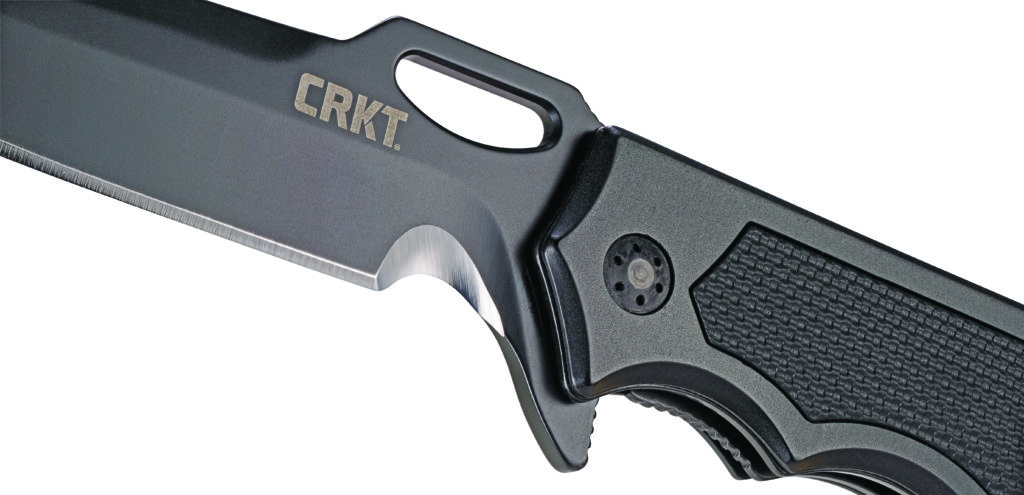
The ergonomic handle has T-6 6061 aluminum scales with textured TPR (thermoplastic rubber) inlays for grip enhancement. Two stainless steel liners provide the knife’s backbone. The linerlock engages securely. The clip is mounted to carry the closed knife blade tip up and as deep as possible in the pocket. Multiple grooves provide comfortable placement to wrap your fingers around the handle. A solid steel spacer anchors the rear of the handle and includes a lanyard hole. The Septimo is an ideal tactical folder for those in law enforcement and the military. Thanks to its distinctly angled tip, the tanto blade has a great reputation for penetration power.
Septimo Deals
Halfbreed Blades CCK-03 Tuhon Raptor

Tuhon Raptor Specs
Blade Length: 3.94″
Overall Length: 7.79″
Weight: 3.53 oz
Blade Steel: Bohler K110
Handle Material: G10
MSRP: ~$165
Pros
- Compact and Discreet
- Ergonomic Grip
- Live Edge Identifier
Cons
- Maintenance Requirements
The Halfbreed Blades CCK (Compact Clearance Knife) series was developed as low-profile bladeware for fast-access self-defense situations. Designed for discreet carry, the series shares a common handle design but with varied blade patterns. The handle is very slender and features a ring at the end, which accommodates an index finger to lock in your grip. The top of the ring has an indentation to seat the thumb comfortably, as well as aid in applying downward pressure on the blade. The CCK-03 Tuhon Raptor is one of the most distinctively shaped blades in the series.
Designed by Special Operations CQC instructor Jared Wihongi, the blade is designed to be implemented in multiple ways, including to trap and hook. The talon-shaped tip has a devastatingly e effective ability to slash as well as thrust, with its slight hook implementing a gathering action. The main and top edges offer options for slashing in either direction. While most of the blade is sharp all the way around, a portion is unsharpened to incorporate a feature called a live edge identifier. It can be seen as a raised protrusion on the handle. You can use it to index the knife, that is, determine by the feel which way the blade is oriented.
The talon-like tip of the Halfbreed Blades Tuhon Raptor acts as your own personal claw. The curved edge grabs and feeds on the material to be cut—as in slicing a section of air hose lengthwise—thus amplifying the force applied.
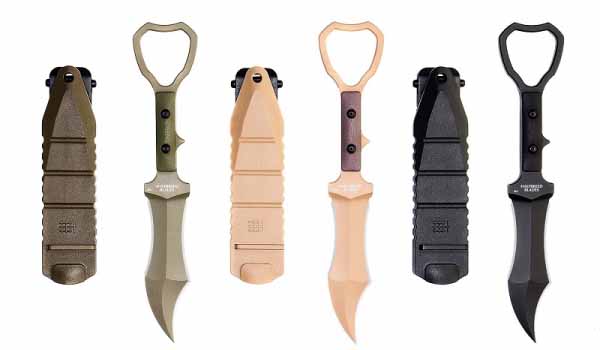
At 8 inches overall and sporting a 3.94-inch blade, the Tuhon Raptor has plenty of length to get the job done while remaining compact in nature. The D2 blade steel boasts a balance of toughness, edge holding and value pricing. The knife comes in three hues: black, desert tan and OD green. Each color permeates the knife with matching G-10 handle overlays. The injection-molded plastic sheath corresponds in color to match the knife. It is a single-column design molded as one piece, not halves riveted together. The sheath is MOLLE compatible and there’s a Blade-Tech Tek Lok for those who prefer belt carry. The knife locks into the sheath very securely—no worries about it falling out accidentally. It locks with a firm and deliberate push.
Unlike the other two test pieces, the Tuhon Raptor is a single-purpose modern tactical knife. It is meant for self-defense and not as a utility tool. The handle design is not conducive for lengthy cutting in a traditional grip. However, in a pinch it can be used as a scoring tool or even to open packages and mail. Nonetheless, if you want to use the knife for self-defense, you should not subject it to any sort of utility use to preserve the sharpness of the edge.
CCK-03 Tuhon Raptor Deals
Fallkniven R2 Scout

R2 Scout Specs
Blade Length: 3.15″
Overall Length: 7.13″
Weight: 4.66 oz.
Blade Steel: Elmax
Handle Material: Thermorun
MSRP: ~$181
Pros
- Sturdy Design
- Good Blade Steel
- Full-Tang Construction
Cons
- Limited Blade Size
Fallkniven’s R2 Scout is a smaller knife designed for users with littler hands, or for folks who just prefer a somewhat undersized blade. Meanwhile, it’s a myth that smaller knives cannot function as tactical tools. Smaller knives are just as capable, or maybe even more so, as their larger counterparts for certain tactical tasks. They can be just as strong as well.
At only 3.1 inches long, the R2’s drop point blade is .196-inch thick, which is quite thick for a short blade. The thickness is intentional to give the knife strength to withstand heavy-duty tasks. The blade’s ELMAX Swedish stainless particle steel is known for superb edge holding, and its Scandi grind descends straight down to a sharp edge. This is known as a zero edge because there is an absence of a cutting-edge bevel. What results is a blade that’s very sharp and easy to maintain.
The Fallkniven R2 Scout’s extra-thick blade enables it to tackle tougher tasks such as baton work easily. The extra thickness works as a wedge to split wood quickly. Country of origin: Sweden.
The zero-grind edge of the Fallkniven R2 Scout has excellent bite and is great for whittling tasks that require the ultimate in sharpness.
The sheath of the R2 carries well on the belt and has the freedom to move when you sit down or snag it on something. (Fallkniven image)
The handle is Thermorun, a sturdy, grippy plastic with rubber-like properties. It has a coarse textured finish on the sides, which does a great job at preventing the handle from slipping out of your hand in adverse conditions. The sheath is equally well thought out, too. Molded of Zytel, it incorporates a webbing belt loop and an imaginative locking system that holds the knife securely. Activate the lock and the knife is guarded against accidental loss. You also can choose not to activate the lock, as the sheath otherwise holds the knife via an ever-present spring detent.
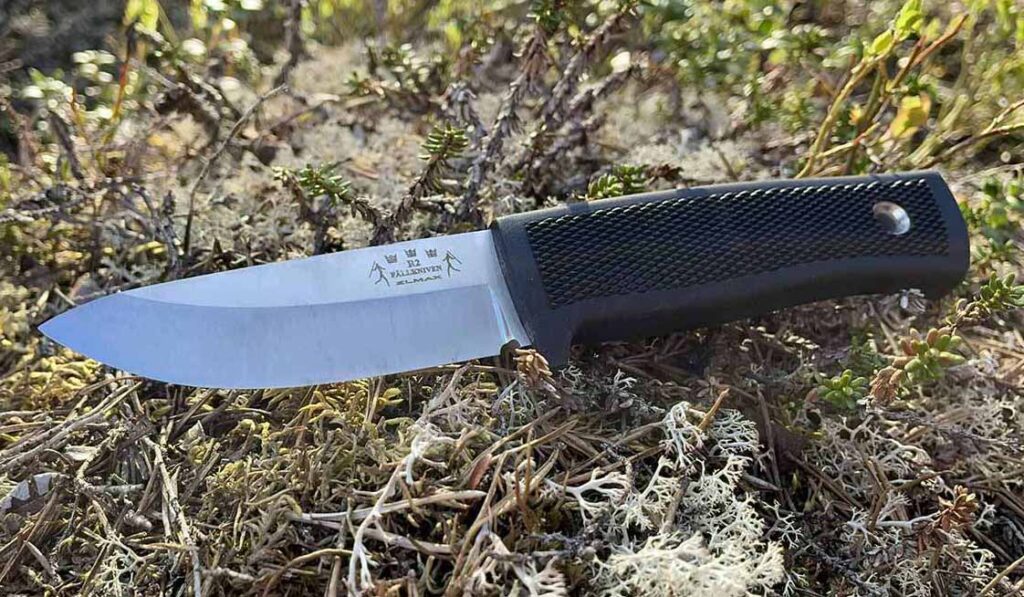
The sheath carries well on the belt and has freedom to move in case you sit down or snag it on something. The R2 is a workhorse of a compact fixed blade. The zero-grind edge has an incredibly aggressive bite. The blade is well suited for camp chores, food prep and carving/whittling utility jobs. As thick as the blade is, don’t be afraid to use it hard. Dig right in with it without worrying about the blade tip breaking or the blade bending. It withstands batonning well. Full-tang construction lends it a nice balance. Since the tang protrudes a bit through the handle butt, you can use it as a crushing tool. I found the texture of the handle to be just right; it gives a great grip in all conditions.
R2 Scout
Bear Edge Brisk 1.0

Edge Brisk 1.0 Specs
Blade Length: 3.635″
Overall Length: 8.625″
Weight: 5.2 oz.
Blade Steel: 440 Stainless Steel
Handle Material: Zytel
MSRP: $35
Pros
- Sharp Out of the Box
- Partially Serrated Blade
- Easy to Carry
Cons
- Not Ideal for Hard Use
The Bear Edge Brisk 1.0 tactical fixed blade features a 4⅞-inch modified drop-point blade of 440A stainless steel with a black-epoxy-type coating. The cutting edge is partially serrated to power through tough materials. The ergonomic handle is stainless steel with a soft touch coating for grip comfort. Five oblong holes through the full tang and handle provide additional grip traction, as well as lighten the load. A large forward finger recess aids in indexing your grip, and the dropped-butt design helps seat your fingers and prevent your hand from sliding backward off the handle. The lower integral guard and choil allow you to employ a choke grip for precise cutting tasks. The knife has a folder counterpart in the Brisk 1.0 series, which, along with the slimmed-down handles, explains why the fixed blade sports a folder look.
While the knife has an overall tactical appearance and feel, it seems better suited to outdoor use. Why? The blade grind is hollow. Most tactical fixed blades have a flat grind to leave more steel in the cross-section, therefore increasing lateral strength. And then there’s the slim handle. For a tactical fixed blade, the handle needs to be wider to accommodate a secure grip. The thin handle doesn’t feel that secure in-hand, so I would be hesitant to use it for tactical tasks. While the slim handle minimizes weight and bulk, making the knife carry on a belt very easily, it’s just not geared toward a hard-use environment most tactical fixed blades must tackle.
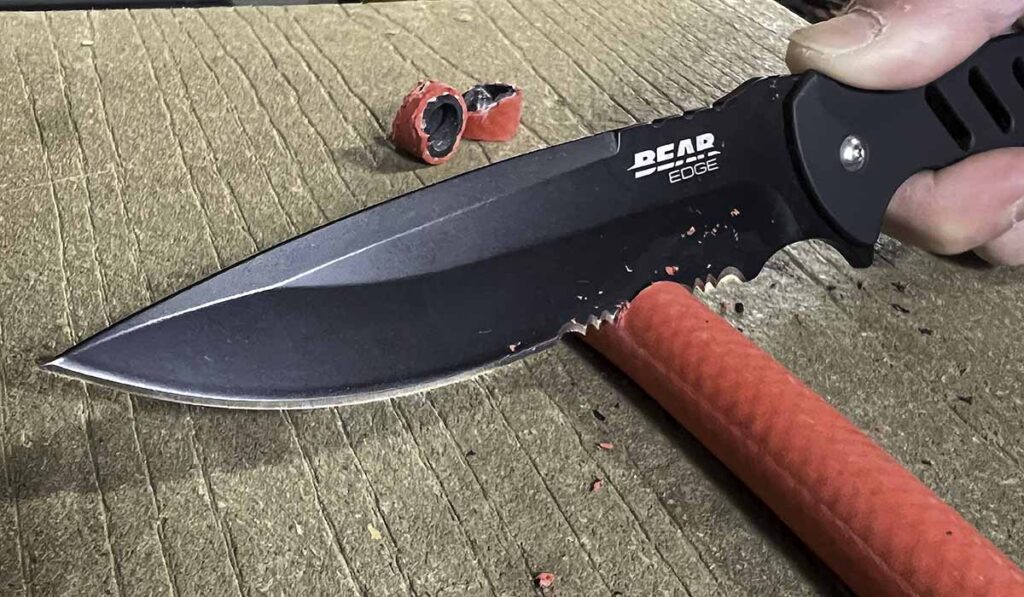
As for the blade, it slices easily. The edge was extremely sharp out of the box and had the right amount of bite that I prefer, though it won’t last long due to its lower-end 440A stainless. It’s just not a steel known for edge holding. Conversely, it’s easy to sharpen in the field because it’s not wear resistant. Hence, if you prefer stainless blades for outdoor leisure activities and don’t want to fool with the extra care of carbon steel blades, consider the Brisk 1.0. The serrations are equally as sharp and eat through fibrous materials with ease. Those who love partially serrated blades will enjoy their versatility with cutting tasks. Plus, it saves you from carrying a separate serrated knife.
The knife includes a ballistic nylon belt sheath with button-snap closure. It’s a basic style sheath, nothing to get excited about. It just does the job.
Brisk 1.0 Deals
Benchmade Adamas
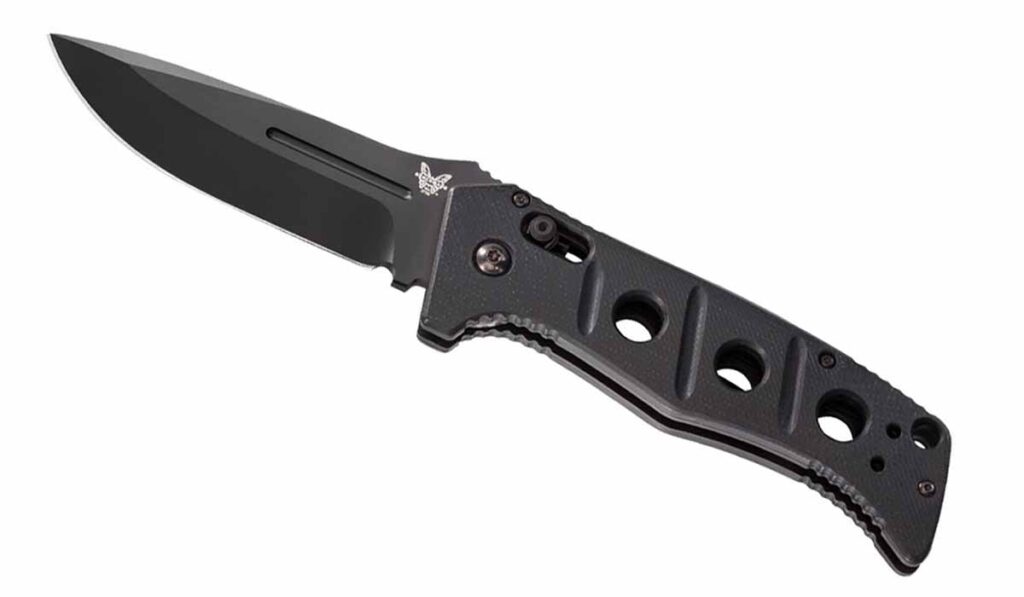
Adamas Specs
Blade Length: 3.82″
Overall Length: 8.93″
Weight: 6.54 oz.
Blade Steel: CPM-Cru-Wear
Handle Material: G10
MSRP: $325
Pros
- Durable Blade Steel
- Axis Lock Reliability
- Ergonomic Handle
Cons
- Thick Handle
The Benchmade Adamas is a stout, full-on, all-in tactical folder that oozes brawn and might in appearance and has the muscle to back it up. Knifemaker Shane Sibert designed the Adamas series and is known for heavy-duty tactical folders and fixed blades. The original comes in a larger size with a 3.7-inch blade, but customers started asking for a more pocket friendly, scaled-down version. Enter the Benchmade 273GY-1 Mini Adamas. With a blade of 3.25 inches and at 4.35 inches closed, the Mini Adamas is probably the toughest small folder you’ll ever meet.
The drop-point blade is CPM Cru-Wear tool steel to go the distance in edge holding and toughness—two important factors in tactical knives. The blade has a fuller milled in on both sides and sports dual conical-shaped thumb studs for easy one-hand opening. The tank-like handle comes in a choice of black or OD green G-10. The design incorporates three holes and milled grooves to enhance grip and aesthetics.
The Axis™ Lock provides the ultimate in blade lockup while being easy to disengage and close. Integral forward and rear lower guards prevent your hand from sliding off, and a deep-carry pocket clip positions the knife blade tip up. Additional screw holes permit relocating the clip to accommodate southpaws.
The Mini Adamas is a good chunk and larger and wider than other mini folders. Compared with its bigger brother, the 275 Adamas, it’s scaled down. Still, it carries better in the pocket and is easy to deploy. The Axis Lock has a longstanding reputation as one of the best locks on the market, and Benchmade has it dialed in with being ultra-solid yet easy to operate—even for novices. If you like the Adamas design but say the regular size is too big for EDC, the 273 is for you.
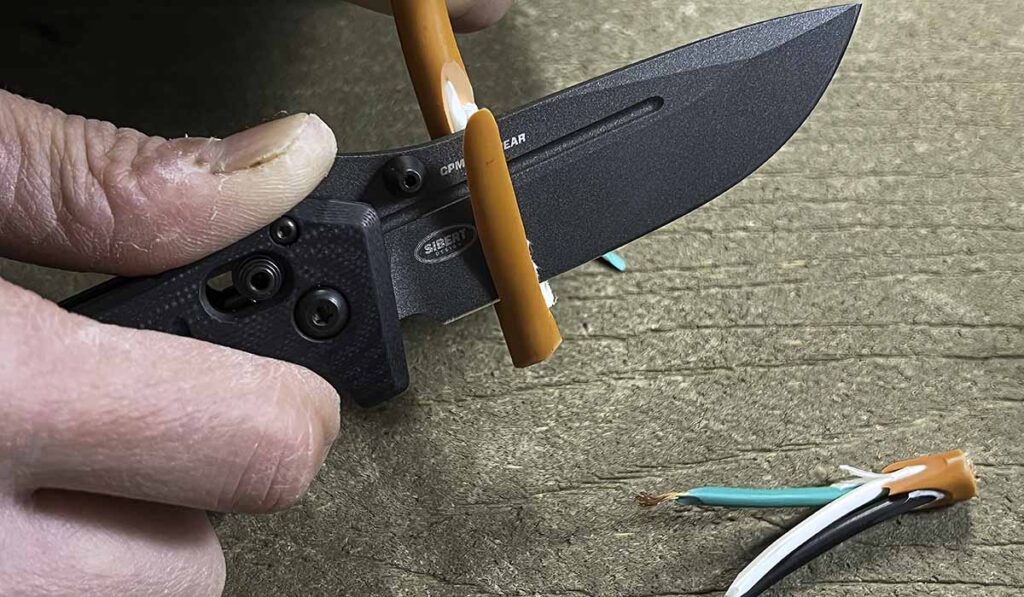
A common complaint about mini folders is when you reduce the size, it changes the in-hand dynamics from the original. Not so much here. There’s still plenty to hold onto! The same cutting power and durability is present, and the boxy handle shape is still comfortable in-hand, more so than you expect—which is a good thing. It is a good working folder and/or tailored for hiking, camping and other outdoor activities.
Cru-Wear goes the distance and is a perfect choice for such a knife. It isn’t stainless so you will have to take some care of it, even though it has a Cerakote coating. The tungsten gray Cerakote has some sparkle to it, is kind of reminiscent of Teflon-coated cookware, and goes well with the black G-10 handle. Don’t be fooled, this mini is definitely mighty.
Adamas Deals
CobraTec Special Ops

Special Ops Specs
Blade Length: 3.75″
Overall Length: 8.625″
Weight: 5.9 oz.
Blade Steel: M390
Handle Material: Titanium
MSRP: $500
Pros
- Durable Blade Design
- Smooth Flipper Action
- Aesthetically Unique
Cons
- Handle Could Be Better
I would have to put the CobraTec Special Ops in the large folder category. It’s built like a tank. The blade is stout, with a well-executed grind. It’s thick enough to have plenty of strength for hard use yet fine enough to create a keen cutting edge. It is definitely not a folding pry bar.
The knife has a blade thumb hole and a flipper for opening. The thumb hole is a little too close to the scale for me. Having the hole so close prevented me from opening the blade smoothly; I just couldn’t get a comfortable angle on it. On the other hand, the flipper is so smooth it’s like that first sip of a good coffee in the morning. I just love the fast, crisp action.
CobraTec takes advantage of the titanium handle by using a framelock system. As the blade opens, the locking bar slides over smooth and easy for a bank-vault action. The dimensions and finish are down pat on the framelock. Sometimes on framelocks you find the lock binds a bit. Not on the CobraTec—everything seems to flow on the knife’s action.

Handle fit is spot on. As for the texturing, it is a milled CNC design. I understand the urge to look different and have appealing aesthetics but the most important thing should be ergonomics. I am not saying the knife is painful to hold but it isn’t like a broken-in pair of house slippers, either. At this price range, grabbing the handle should give me shivers. If the handle ergonomics were as sweet as the action, I would be a new fan boy. The pocket clip is too tight. A large blade provides plenty of length for penetration. The knife is a solid build so there is no reason why you can’t expect faithful service from it for a lifetime.
Maserin 920/TP Tactical

920/TP Tactical Specs
Blade Length: 3.582″
Overall Length: 8.26″
Weight: 3.95 oz
Blade Steel: 440C Stainless steel
Handle Material: Black Anodized Aluminum
MSRP: ~$165
Pros
- Functional Blade Profile
- Compact and Nimble Design
- Corrosion Resistance
Cons
- Overly Tight Sheath
I would call the Maserin 920/TP Tactical a small boot knife or even a modern dagger. It has a dagger blade profile with one side a combination serrated/razor and the other a false edge. Keep in mind dual-edged blades are illegal in some areas, so know your local laws before you decide to sharpen the second side.
The guard is integral to the handle. A mechanical system fastens the aluminum scales to the blade. The 920/TP is not a full-tang knife. Maserin screws the scales to a short tang and then uses spacers at the back, somewhat like a folder. A through-handle construction such as this does not lend the knife to extreme hard use. The 440C stainless blade steel is tolerant of close-to-the-body carry without getting rusty, and the heavy blade coating helps resist rust.

A molded Kydex sheath accommodates MOLLE and horizontal or vertical belt carry. The sheath was so tight that I struggled to pull the knife out. I’m not a strongman competitor and I don’t want to have to work that hard. After repeated drawing, unsheathing the knife did become manageable. I would say the grip is good and serviceable. Overall, the knife is light and nimble but is not built to abuse. I think it would make a good 4:30 or vest carry.
Hogue Deka Manual

Deka Manual Specs
Blade Length: 3.25”
Overall Length: 7.5”
Weight: 2.3 oz
Blade Steel: CPM 20CV Stainless Steel
Handle Material: G10
MSRP: $195
Pros
- Ambidextrous Pocket Clip
- User-Focused Design
- Reliable Everyday Carry
Cons
- Pocket Clip
According to Hogue, the Deka Manual is one of its more popular folders. It’s easy to see why, since without missing any points on style it maintains a straightforward user design. CNC-milled G-10 scales with a “V” design are basic in nature yet effective in helping gain a solid hold. An Ambidextrous Bar Lock Enhanced (ABLE) mechanism secures the blade open. Simple to use and very convenient, the lock matches up well with the thumb stud blade opener. You can pull back the lock and give the knife a decent flick to open it as well.
I would like to spend some time on the blade. Aesthetically, the wharncliffe pattern the company uses isn’t my cup of tea, though I must say the design has plenty of utility and for that reason alone has appeal. Hogue uses a compound angle grind. At the base, the edge starts out following one angle and then takes a crisp but slight upward angle. Wharncliffe tips give plenty of engagement to manipulate the point during cuts. Add the gimping on the thumb ramp and you can control the force you drive into the cut.

The Deka has a deep carry, ambidextrous pocket clip that carries the knife tip up. I would like to see a sturdier clip but it does its job, and I had not experienced any issues with it as of press time. Sometimes the simple designs stand out most because they are solid users. I think the Hogue is a user-driven knife, unlike many knives that are popular for their Gucci factor. It comes in more colors than black but since there’s a black one it can be tactical.
Editor’s Note: Steve Shackleford and Abe Elias contributed to this report.
Check Out More Buyer’s Guides:
- Best EDC Fixed Blade Knife Options
- Best Bushcraft Knife: When Steel Meets The Woods
- Best Neck Knife: Options To Yoke Up With
- Best Tomahawks: Our Top Hawks For Backwoods To Battlefields
 NEXT STEP: Download Your Free KNIFE GUIDE Issue of BLADE Magazine
NEXT STEP: Download Your Free KNIFE GUIDE Issue of BLADE Magazine
BLADE’s annual Knife Guide Issue features the newest knives and sharpeners, plus knife and axe reviews, knife sheaths, kit knives and a Knife Industry Directory.Get your FREE digital PDF instant download of the annual Knife Guide. No, really! We will email it to you right now when you subscribe to the BLADE email newsletter.







